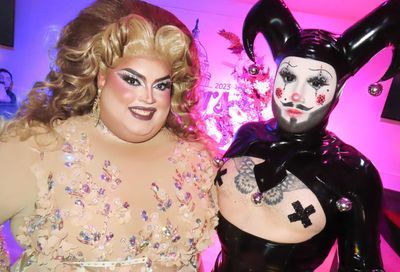Good Taste
As the longtime restaurant critic for The Washington Post, Tom Sietsema has turned dining out into a fabulous -- and enviable -- lifestyle.

Photography by Todd Franson
“One favor I’m going to ask of you,” Tom Sietsema says warmly, “is that you please refrain from any physical description of me. That would be great.”
The reporter nods in acknowledgement. Sietsema takes a sip of freshly brewed coffee. He smiles.
“I appreciate that.”
To be extremely well-known, citywide, yet to not be known at all, to be an anonymous diner — but no, not really, because supposed photos of you hang in restaurant kitchens around town – to ensure that when you’re photographed by a local magazine, a plate fully covers your visage. Such is the existence of a restaurant critic for a major metropolitan daily.
Tom Sietsema is the restaurant critic for The Washington Post, a position held previously by the indomitable Phyllis Richman. Richman was a hard act to follow, but in 14 years Sietsema has made the section his own, bringing his own voice, his own sophistication, his own connect-with-the-reader sensibility to the Sunday reviews, which are authoritative, down-to-earth and, when he loves a particular dish, downright mouthwatering. His way with a descriptive passage is unparalleled, and his knowledge of food vast. He has, if not exceeded, at least equaled his legendary predecessor.
Like Richman, a rave from Sietsema can send a restaurant’s fortunes soaring, while a pan can have quite the opposite effect. Yet, also like Richman, Sietsema wields his power with fairness. He knows how tough the business is — and he genuinely seems to want the places he writes about to succeed. Yet he’s always mindful of his audience — he’s there for the reader, not, as he puts it, “a cheerleader for the chefs.” Unlike Richman, who pretty much was the only game in town, Sietsema is a critic in the Internet era, competing with crowdsourcing apps like Yelp or amateur food bloggers, some of whom likely couldn’t boil a pot of water. And while some of those opinions out there count, it’s safe to say Sietsema’s count more.
There are restaurant owners who might disagree with that assessment. Yet there’s no denying this gay man, a native of the Midwest whose food-journalism career has taken him from The Washington Post to the San Francisco Chronicle to the Seattle Post Intelligencer to Sidewalk.com and back, full circle, to the Post, loves his job more than anyone should have a right to.
And why not? He gets to eat out every single night and day, at venues fancy and plain, around the country, around the world, all on the dime of his employer. He writes the weekly review in the Post Magazine, but also pens columns for the Wednesday edition of the paper as well as for the publication’s website.
“I go to more restaurants than you might read about because I’m always scouting,” says Sietsema. “I might follow up on a couple of reader tips or check out a new Austrian place in Northern Virginia. My whole thing is that it has to be worth a couple million readers knowing about. It has to appeal to sort of a general audience.”
He does his best to be diverse in his weekly selections.
“So many new places have opened up,” he continues, marveling at the former wasteland that was 14th Street, now a culinary paradise. “I’ve got a backlog of about 20 right now. What I like to do is mix it up, so every week there’s something in a different price range, a different cuisine style, a different location. We’re really in this really exciting restaurant boom … around the city.”
Clearly, it’s a good time to be a restaurant critic in Washington, D.C. And, just as clearly, Tom Sietsema is having the time of his life.
METRO WEEKLY: What is your first memory of food? Of eating it, experiencing it?
TOM SIETSEMA: I grew up in the ’60s and ’70s in rural Minnesota. Food was pretty important to my family — I was surrounded by good food as a kid. My mom was a fabulous home cook. Her leftovers tasted like first-timers. She was sort of like the original super-mom in that she had a job as a public health nurse for the county. She would come home during her half-hour lunch break and whip up some casserole or something so that we all sat down to dinner at 5:30 promptly every night when my dad got home from work. We always sat down to dinner every night. That was really important, I think.
We did not have sugary cereals. We did not have Hostess in the house. She would make her own donuts, her own french fries, her own vanilla pudding. She would doctor Campbell soup or Jell-O or something like that to make it more festive or homier, or make it taste like a real person made it. The kitchen was where we always gathered at home, and as we were eating lunch or dinner, we’d be thinking about the next meal that we were going to have. We were always talking about food so it was a very important thing for us.
MW: Did you eat out much at restaurants?
SIETSEMA: There weren’t a lot of restaurants where I grew up. But we would go to the Nan King in Minneapolis for Chinese food. When I think about it now, was Nan King really a good Chinese restaurant or was it just so different and so exotic for us as kids that we liked it?
MW: How did the food career come about?
SIETSEMA: Happenstance. When I was at Georgetown, I took a class with Ted Gup, who was an investigative reporter at The Washington Post. After I graduated, I was a waiter at Pizzeria Uno mulling my life and he called and said, “Hey, they’re looking for some copy aides here at the paper.” And I said, “Oh, that would be awesome.” You know, get a foot in the door. And when you’re there and you’re working in the mailroom and sorting papers and doing whatever the editors want you to do, you’re always looking for job opportunities. One day, Bob Woodward was looking for an assistant, as was Phyllis Richman, the food critic. So I applied to both. I got a very nice “thanks, but no thanks” from Bob Woodward and a “Let’s try this out for a week” from Phyllis Richman. And so for a week I did research on a story that she was doing on chocolate. I answered her phones. I tested some recipes. And she said, “This is going to work. Do you want to be my assistant?” And I said, “Sure.”
It was interesting, because she wielded a lot of power — this was pre-Internet — she was both the food editor and the restaurant critic. She traveled and would come back with a sheaf of recipes for me to test. I would go home at 2 o’clock in the afternoon. I’d go shopping. I was making no money, but my weekly grocery bill, courtesy of the Post, was double the amount of my monthly rent. I was eating very well. It was just crazy.
MW: Were you at all intimated by the cooking?
SIETSEMA: I guess what they liked about me was that I sort of represented Joe Reader. I would look at a recipe and I would have the kinds of questions that the average reader would have. Certainly, over time, it’s like anything else — like singing or playing an instrument or cooking. Practice does make perfect. You become much better at chopping onions or knowing when a cake is done or whatever. It was a great learning experience because you got your hands dirty. I was cleaning squid, and buying expensive cuts of meat, and getting to work with all sorts of things that I had not encountered before — you know, herbs and such, making my own brioche — and then I would bring in little samples for her to try so she could evaluate them and then they would run in the paper. I learned how to edit recipes. I learned what a good story and a bad story was. It was an awesome time to be at The Washington Post.
MW: She was such a legend in the industry. What was it like working with her?
SIETSEMA: I was so in awe of her. It took me about a month to stop calling her Mrs. Richman. She was intimidating. She was a taskmaster — very smart, but also a really good boss. She didn’t just spread the compliments around, so if you got a compliment from her, you knew you earned that. She gave me opportunities at the paper. She launched my career.
MW: You went on to write reviews for the Post’s suburban sections and later left to head up food sections and restaurant reviewing in other cities. But, years later, you landed back where you began.
SIETSEMA: I was working for [Microsoft’s] Sidewalk.com, and it was such an exciting time because their pockets were deep, deep, deep and you got to work with the best technology in existence. But they pulled the plug on it and I was hired by The Washington Post to be temporary food reporter for someone who was out on sick leave. And that turned into a fulltime gig. A year later, Phyllis Richman announced her retirement. She told me a week or so before it became public, “I’m going to retire — get your ducks in a row.” And she was so supportive throughout this. It was a very stressful time because she had the job for almost 24 years and these jobs are not exactly abundant, and the people in them tend not to leave. I think it really does help to have a sense of history about a place, but when I look back, I think, “Wow, everything I was doing early on was sort of working toward coming back to Washington.”
MW: How long have you had the position now?
SIETSEMA: Since 2000.
MW: How do you feel about all these crowd-sourced reviews? Are these helpful or hurtful to the craft of restaurant criticism?
SIETSEMA: Well, I think that opening up the field is a good thing. Anytime you have competition it keeps people on their toes. It keeps people like myself from becoming lazy or less nimble. I’m all for that. And the more people talk about restaurants the better.
MW: Whom should we trust then when making our dining decisions?
SIETSEMA: I think it always pays to do a little research. Whether or not you agree with me, at least you know all my meals are being paid for by the Post. No one is telling me which restaurants to review. I have a very, very long leash that I am grateful for. You don’t go into this job to be loved, for sure. My job is to look out for the reader. I don’t expect readers to always agree with me. But I spend over 40 hours a week in a restaurant. I eat out an average of 13 meals a week. That’s a lot. Who else does that? Someone on Yelp? How would they get their job done if they were doing something like that? And how do they pay for it? Where’s that come from?
My point is that whether or not you agree with the critic at a major newspaper or magazine, you do know that his or her work is being paid for by the employer for the most part, and he or she does not accept freebies and is more or less free to write about what he or she wants to write about. You can believe me or not believe me based on that, I think.
MW: What about the people who just food blog and then suddenly are picked up on by the masses?
SIETSEMA: Good for them. Lucky them. I came up the old fashioned way. I don’t expect everyone to do that, but I do think that it’s important to know how food goes together, what it looks like, what the combinations are. I mean you don’t have to work at a newspaper for years and years and years to do that. There are some really good amateur food writers out there and I think it’s upped the bar a little bit. It would behoove journalists at traditional newspapers to pay attention. I love that so many people, just in our market here, are covering food — the Washington City Paper, Eater, your publication. We have more coverage in the Post right now. Food is not just relegated to a dining review or the food section anymore. It’s part of the general conversation. Food is very often A-1 news, whether it’s a trend, whether it’s hunger, whether it’s the business of agriculture — food is part of our daily conversation.
Support Metro Weekly’s Journalism
These are challenging times for news organizations. And yet it’s crucial we stay active and provide vital resources and information to both our local readers and the world. So won’t you please take a moment and consider supporting Metro Weekly with a membership? For as little as $5 a month, you can help ensure Metro Weekly magazine and MetroWeekly.com remain free, viable resources as we provide the best, most diverse, culturally-resonant LGBTQ coverage in both the D.C. region and around the world. Memberships come with exclusive perks and discounts, your own personal digital delivery of each week’s magazine (and an archive), access to our Member's Lounge when it launches this fall, and exclusive members-only items like Metro Weekly Membership Mugs and Tote Bags! Check out all our membership levels here and please join us today!






















You must be logged in to post a comment.